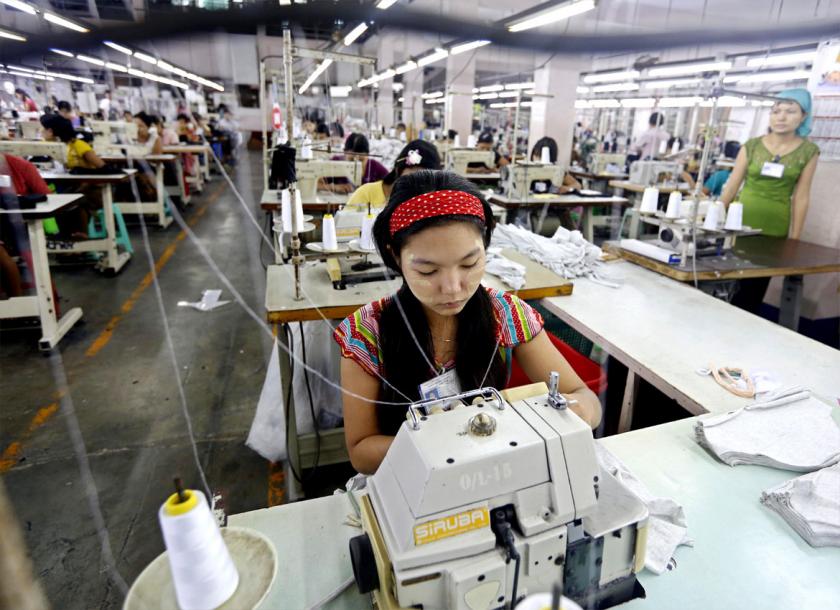Demands are still remain despite Industrial zones are hampered by poor infrastructure have held back investments
25 มกราคม 2562
Demand for Myanmar’s industrial zones beyond Yangon is bound to grow but poor transport and energy infrastructure have held back investments, a major study suggests.
Business information firm Frontier Myanmar Research (FMR) last week at the Yangon Stock Exchange launched its Myanmar Industrial Zone Review, a study based on reviewing approximately 100 active, developing and proposed industrial zones across the country.
Industrial zones in Yangon Region benefit from geographical proximity, and hence many better-run zones are being filled up. This has driven up the land prices of industrial estates near the commercial capital.
To add to the problem, the government’s effort to push back on land speculation has yielded little success. The price increase has led investors to look beyond Yangon Region.
“As this process continues, we see an increasing rise of industrial activities based in nearby states and regions, specifically Bago, Ayeyarwady and Mon,” FMR’s Jeremy Mullins said during the launch event.
“Looking further afield, there is growing interest in other parts of the country, and we see some interesting opportunities in upper Myanmar as well.”
Currently, Myanmar has 63 industrial zones and parks in operation, occupying 25,425 of land in all the states and regions, with the exception of Chin State. Of all the industrial estates, 65 percent are located in the Yangon Region.
Industrial estates outside Yangon also face difficulties. Notably, Myotha Industrial Park in Mandalay Region and Pathein Industrial City in Ayeyarwady Region suffer from poor transport connectivity to arterial highways and railroads owing to their locations.
Many existing industrial zones were developed throughout the 1990s and early 2000s by the Department of Human Settlement and Housing Development (DHSHD) or various Regional Military Commands under the State Peace and Development Council (SPDC) government. These zones have struggled to attract significant investment, and have faced a number of development headwinds due to large infrastructure gaps and low maintenance and upkeep.
The Myanmar Times spoke to a few panellists during the event.
Under such deficiencies, Paul Moynihan, general manager of the Australian firm RJE Myanmar, pointed out that enormous investments are necessary in sustaining the existing zones and planning for new ones.
In contrast, Myanmar’s first and only Special Economic Zone (SEZ) secured significantly more institutional and financial support to develop the area and push ahead with connectivity. Thilawa SEZ has attracted US$1.5 billion in foreign investments to date. Initiated by U Thein Sein’s government in 2013, the SEZ has its own river port and is building a new Bago River bridge.
U Myint Zaw, general manager of Thilawa’s developer Myanmar Japan Thilawa Ltd (MJTD), emphasised that the four key factors for the industrial zones are infrastructure within the estate and transport connectivity, reliable electricity supply, environmental care and mechanisms to address local community relations.
“The government is doing as much as it is capable of doing,” Mr Moynihan observed. Nonetheless, the bureaucracy is understaffed and needs to scale up its capacity.
Power is one of the key challenges. Myanmar’s electricity prices, financially unsustainable and with rates being the lowest in ASEAN, remains unchanged despite years of deliberation by the authorities.
Apart from investing in the infrastructure of the new zones, Mr Moynihan said the Ministry of Electricity and Energy (MOEE), which is running a loss due to the subsidies, needs to address the energy tariffs structure.
The National League for Democracy-led government has yet to undertake tariff reforms. Currently, the wealthiest residents in Yangon purchase subsidised electricity below cost.
Labour availability, hampered by the lack of staff housing, presents another challenge.
“There is definitely a lack of investment in ancillary or support infrastructure such as staff housing, fire stations, IT infrastructure etc, in state-developed industrial zones,” FMR's research manager Chris Markey commented.
On the contrary, some private zones include staff housing in their development plans.
Ayeyarwady Region, Mandalay Region and Shan State have a plenitude of available labour due to their large working-age populations.
These regions, hence, have the potential to take on new demand. Meanwhile, the lack of skilled labour, especially outside Yangon, is holding back advanced manufacturers and import substitution industrialisation.
Overall, the growth of Myanmar’s industrial zones is set to continue despite the obstacles.
“There is very real investor interest in Myanmar industrial zones. Some quality industrial zones are sold out or close to it, particularly in Yangon.
As long as there are no major macroeconomic disruptions, we expect this situation [growing of industrial zones] to continue,” Mr Mullins observed.
FMR Research and Advisory is a subsidiary of UK-based research services provider MEA Frontier Ltd.
(The Myanmar Times: https://www.mmtimes.com/news/industrial-zones-hampered-poor-infrastructure-demand-remains.html )











